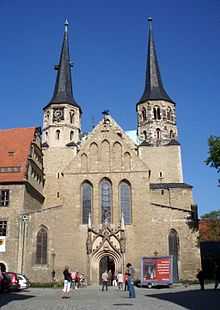Thietmar of Merseburg

Thietmar (Dietmar or Dithmar) of Merseburg (25 July 975 – 1 December 1018) was a German chronicler who was also bishop of Merseburg.
Life
Thietmar was a son of Siegfried the Elder, count of Walbeck (d. 15 March 991), and was related to the family of the emperor Otto the Great, and Kunigunde (ca. 956–13 July 997), daughter Henry I the Bald, Count of Stade (House of Udonids). Thietmar was educated at Quedlinburg and at Magdeburg, became provost of Walbeck Abbey in 1002 and bishop of Merseburg seven years later. He took some part in the political events of the time; in 994 he was a hostage in the hands of the Northmen, and he was not unfamiliar with the actualities of war.[1]
He died on 1 December 1018 and was buried in Merseburg cathedral.[1]
Thietmar's Chronicle

Between 1012 and 1018 Thietmar, while Bishop of Merseburg, composed his chronicle "Chronicon Thietmari, which comprises eight books,[2] that cover the period between 908 to 1018, the Saxon Emperors Henry the Fowler, the three Ottos, and Henry II the Saint. As counsellor of the Emperor and participant in many important political transactions he was well equipped for writing a history of his times.
The first three books, covering the reigns of Henry I and the first two Ottos (Otto I and Otto II) are largely based on previous chronicles most of which are still extant (e.g. Widukind of Corvey's Res gestae Saxonicae, the Annales Quedlinburgenses and others); the fourth book, comprising the reign of Otto III contains much original matter; while the remaining four books, which describe the reign of Henry II to the year 1018, are the independent narrative of Thietmar and, besides being the principal source for Saxon history during the reign of Henry II, contain valuable information, not to be found elsewhere regarding the contemporary history and civilization of the Slavic tribes east of the river Elbe, as well as Poles and Hungarians peoples.[2]
The Latin style and the composition are not of a high standard, largely because, as the original manuscript reveals, Thietmar continued to make amendments and insertions to the text after it was completed. Nor does he always discriminate between important and unimportant events.
The chronicle is nevertheless an excellent source for the history of Saxony during the reigns of the emperors Otto III and Henry II. No information is excluded by Thietmar, but the fullest details refer to the Bishopric of Merseburg, and to the wars against the Wends (Polabian Slavs) and the Poles.
The original manuscript was moved in 1570 to Dresden. When the city was destroyed by bombing during World War II the manuscript was severely damaged, and only a few folios remain intact. Fortunately a complete facsimile edition had been published by L. Schmidt (Dresden, 1905).
Thietmar's statement that the Gero Cross in Cologne cathedral was commissioned by Archbishop Gero, who died in 976, was dismissed by art historians, who thought he meant another cross, until the 1920s, and finally confirmed as correct in 1976 by dendrochronology.[3]
Editions and translations of Thietmar's Chronicle

Thietmari Merseburgensis episcopi Chronicon:
- Mentzel-Reuters, Arno and Gerhard Schmitz. Chronicon Thietmari Merseburgensis. MGH. Munich, 2002. Images of the Dresden MS (prepared by Birgit Arensmann and Alexa Hoffmann), a search facility and Holtzmann's 1935 edition, available online
- Holtzman, Robert (ed.) and J.C.M. Laurent, J. Strebitzki und W. Wattenbach (trs.). Die Chronik des Thietmar von Merseburg. Halle, 2007 (1912). ISBN 978-3-89812-513-0. New publication based on earlier editions and German translations and including 48 illustrations by Klaus F. Messerschmidt.
- Holtzmann, Robert (ed.). Die Chronik des Bischofs Thietmar von Merseburg und ihre Korveier Überarbeitung. MGH Scriptores rerum Germanicarum NS 9. Berlin, 1935. Available from digital MGH
- Wattenbach, Wilhem and Friedrich Kurze (eds.). Thietmari Merseburgensis episcopi Chronicon. MGH Scriptores rerum Germanicarum in usum scholarum separatim editi 54. Hanover, 1889. PDF available online from the Internet Archive.
- Lappenberg, J.M. (ed.). "Thietmari Chronicon a 919-1018." In Annales, chronica et historiae aevi Saxonici, ed. Heinrich Pertz. MGH Scriptores (in Folio) 3. Hanover, 1839. 723–871. Available online
- Warner, David A. (tr.). Ottonian Germany. The Chronicon of Thietmar of Merseburg. Manchester, 2001. ISBN 0-7190-4925-3. English translation.
- Trillmich, Werner (tr.). In Thietmar von Merseburg. Chronik. Ausgewählte Quellen zur Deutschen Geschichte des Mittelalters vol 9. 8th ed. Darmstadt: Wissenschaftliche Buchgesellschaft, 2002 (1957). ISBN 3-534-00173-7. Translation into modern German.
- Holtzmann (tr.). 1938. GdV, 4.Aufl. German translation.
- von Laurent (tr.). 2. Aufl. Berlin, 1879. German translation.
References
- Attribution
 This article incorporates text from a publication now in the public domain: Chisholm, Hugh, ed. (1911). "Thietmar of Merseburg". Encyclopædia Britannica 26 (11th ed.). Cambridge University Press. p. 849.
This article incorporates text from a publication now in the public domain: Chisholm, Hugh, ed. (1911). "Thietmar of Merseburg". Encyclopædia Britannica 26 (11th ed.). Cambridge University Press. p. 849. This article incorporates text from a publication now in the public domain: Ott, Michael (1909). "Dithmar". In Herbermann, Charles. Catholic Encyclopedia 5. Robert Appleton Company.
This article incorporates text from a publication now in the public domain: Ott, Michael (1909). "Dithmar". In Herbermann, Charles. Catholic Encyclopedia 5. Robert Appleton Company.
Further reading
| Wikimedia Commons has media related to Thietmar von Merseburg. |
- Thietmar of Merseburg in the German National Library catalogue
- "Digital edition of the Chronicle, ed. Arno Mentzel-Reuters and Gerhard Schmitz. München : MGH 2002". (full text of the facsimile of the Dresden MS and Holtzmann's edition) (German)
- "Thietmari Merseburgensis episcopi chronicon - notae Germano sermone scripta Latino" (in Latin).
- "Vita Operaque by Migne Patrologia Latina" (in Latin).
- Wilhelm Wattenbach (1894), "Thietmar", Allgemeine Deutsche Biographie (ADB) (in German) 38, Leipzig: Duncker & Humblot, pp. 26–28
| Count Thietmar of Walbeck Born: 25 July 975 Died: 1 December 1018 | ||
| Catholic Church titles | ||
|---|---|---|
| Regnal titles | ||
| Preceded by Wigbert of Merseburg |
Prince-Bishop of Merseburg 1009–1018 |
Succeeded by Bruno of Merseburg |
|